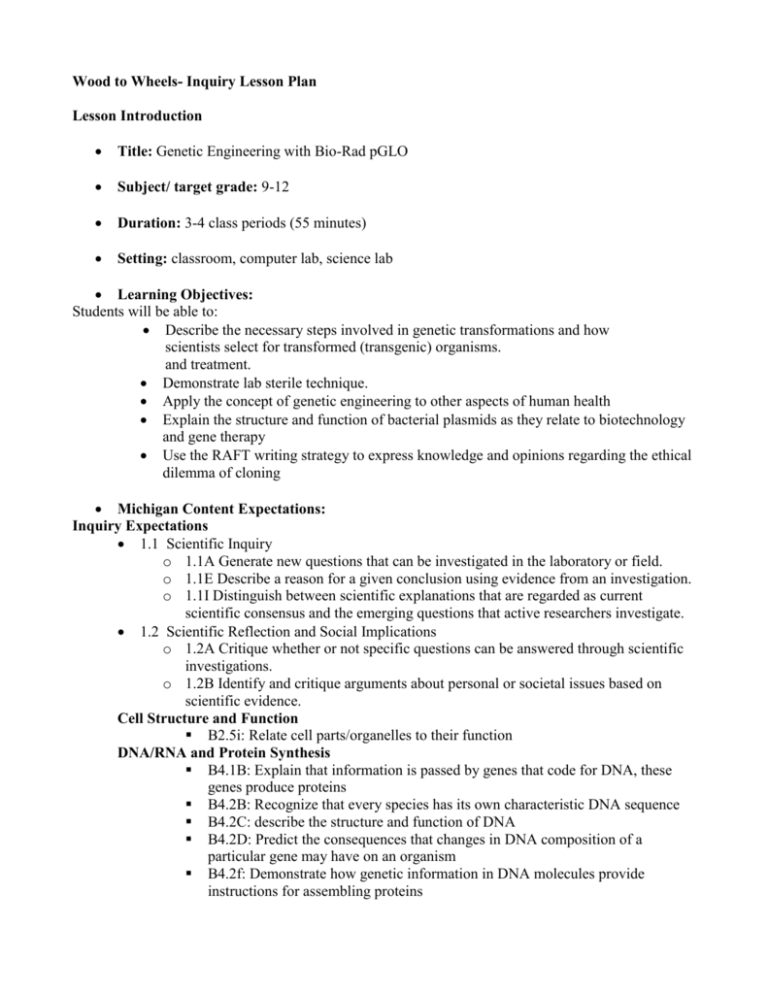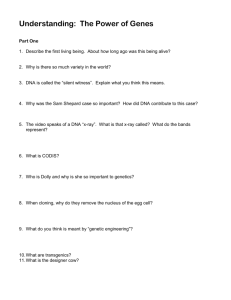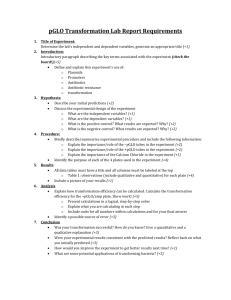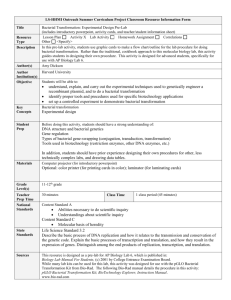Lesson Two Plans
advertisement

Wood to Wheels- Inquiry Lesson Plan Lesson Introduction Title: Genetic Engineering with Bio-Rad pGLO Subject/ target grade: 9-12 Duration: 3-4 class periods (55 minutes) Setting: classroom, computer lab, science lab Learning Objectives: Students will be able to: Describe the necessary steps involved in genetic transformations and how scientists select for transformed (transgenic) organisms. and treatment. Demonstrate lab sterile technique. Apply the concept of genetic engineering to other aspects of human health Explain the structure and function of bacterial plasmids as they relate to biotechnology and gene therapy Use the RAFT writing strategy to express knowledge and opinions regarding the ethical dilemma of cloning Michigan Content Expectations: Inquiry Expectations 1.1 Scientific Inquiry o 1.1A Generate new questions that can be investigated in the laboratory or field. o 1.1E Describe a reason for a given conclusion using evidence from an investigation. o 1.1I Distinguish between scientific explanations that are regarded as current scientific consensus and the emerging questions that active researchers investigate. 1.2 Scientific Reflection and Social Implications o 1.2A Critique whether or not specific questions can be answered through scientific investigations. o 1.2B Identify and critique arguments about personal or societal issues based on scientific evidence. Cell Structure and Function B2.5i: Relate cell parts/organelles to their function DNA/RNA and Protein Synthesis B4.1B: Explain that information is passed by genes that code for DNA, these genes produce proteins B4.2B: Recognize that every species has its own characteristic DNA sequence B4.2C: describe the structure and function of DNA B4.2D: Predict the consequences that changes in DNA composition of a particular gene may have on an organism B4.2f: Demonstrate how genetic information in DNA molecules provide instructions for assembling proteins B4.2g: Describe the process of replication, transcription and translation and how they relate to each other in molecular biology B4.4c: Explain how mutations in the DNA sequence of a gene may be silent or result in phenotypic change in an organisms and in its offspring Mendelian and Molecular Genetics: B4.2h: Recognize the genetic engineering techniques provide great potential and responsibilities B4.4a: Describe how inserting, deleting or substituting DNA segments can alter a gene Lesson Overview: This lesson is centered on the Bio-Rad pGLO Bacterial Transformation Kit. Students will examine how a gene and associated trait from one organism can be isolated, transferred to another organism and replicated. Students will also use the RAFT writing strategy to assess knowledge about the ethical dilemma of cloning. Lesson Core The Guiding Question: What applications can be derived from bacterial transformation? Materials and Equipment Needed: Bio Rad pGLO transformation kit. ***This kit contains enough supplies for 2 classes of 32 students each. Additional equipment not included is listed below. Incubator (37 ° C) Hot water bath (42° C) Using DI water will prevent mineral deposits. 2-4 U-V/ black lights (green fluorescent protein cannot be observed without this light) Ice and small Styrofoam cups Sharpie markers or wax pencils – 1 per group Masking tape Buckets or other containers with 10% bleach solution Safety precautions: The E. coli used in this lab in non-pathogenic, but should be treated as such in the lab. All participants should wear goggles and gloves. All lab supplies, except paper products, should be placed in a 10% bleach solution and soaked overnight. Teacher can then place items in a double plastic bag and place in the trash. Agar should NOT be disposed of down the sink drain as it will solidify and block the drain. Advanced Preparation: For Bio-Rad pGLO Bacterial Transformation Kit Teacher Preparation Step 1 Read through the transformation manual Make a copy of Student Manual and Quick Guide for each student When Immediately Time 1 hr Step 2 Prepare nutrient agar plates 3–7 days prior 1 hr Step 3 Prepare starter plates, aliquot solutions 36–48 hr prior 30 min Step 4 Organize student workstations Immediately prior 10 min Bacterial cultures need to be started 24 hours before the lab and should be no older than 36 hours. LB and other plates can be made up to 1 week before the lab and stored in the refrigerator. Instead of disposing of equipment after bleaching, many items can be washed in hot, soapy water and used for other labs throughout the year. Autoclaving is another option. Background Information for Teachers: (from Bio Rad pGLO Transformation Kit) In this lab, students will perform a procedure known as genetic transformation. Genetic transformation occurs when a cell takes up and expresses a new piece of genetic material—DNA. This new genetic information often provides the organism with a new trait, which is identifiable after transformation. Genetic transformation literally means change caused by genes and involves the insertion of one or more gene(s) into an organism in order to change the organism’s traits. Genetic transformation is used in many areas of biotechnology. In agriculture, genes coding for traits such as frost, pest, or drought resistance can be genetically transformed into plants. In bioremediation, bacteria can be genetically transformed with genes enabling them to digest oil spills. In medicine, diseases caused by defective genes are beginning to be treated by gene therapy; that is, by genetically transforming a sick person’s cells with healthy copies of the defective gene that causes their disease. Genes can be cut out of human, animal, or plant DNA and placed inside bacteria. For example, a healthy human gene for the hormone insulin can be put into bacteria. Under the right conditions, these bacteria can make authentic human insulin. This insulin can then be used to treat patients with the genetic disease, diabetes, because their insulin genes do not function normally. With the pGLO transformation kit, students use a simple procedure to transform bacteria with a gene that codes for Green Fluorescent Protein (GFP). The real-life source of this gene is the bioluminescent jellyfish Aequorea victoria, and GFP causes the jellyfish to fluoresce and glow in the dark. Following the transformation procedure, the bacteria express their newly acquired jellyfish gene and produce the fluorescent protein, which causes them to glow a brilliant green color under ultraviolet light. In this activity, students will learn about the process of moving genes from one organism to another with the aid of a plasmid. In addition to one large chromosome, bacteria naturally contain one or more small circular pieces of DNA called plasmids. Plasmid DNA usually contains genes for one or more traits that may be beneficial to bacterial survival. In nature, bacteria can transfer plasmids back and forth, allowing them to share these beneficial genes. This natural mechanism allows bacteria to adapt to new environments. The recent occurrence of bacterial resistance to antibiotics is due to the transmission of plasmids. Engage: This video clip from the 1931 movie version of is a great discussion starter on life and the idea of using parts from other life forms to create a new life or new traits. "Its Alive" Frankenstein Clip http://www.youtube.com/watch?v=8H3dFh6GA-A This is a classic scene. Almost everybody has heard the famous line,” it’s alive." This scene sets up the outlandish idea that you can take dead parts from a once living thing, put them together, shock it, and create a new life. Nobody could actually think that it would be possible. However, in less than 100 years from the making of this movie science has unlock the secret of life, in the form of DNA, genes and genetics. Building on prior knowledge: After the clip, prompt the class with question about the reality of such an idea. Discuss the difference between physical traits vs. genetic traits. How can a non-living thing bring about life? What is the value of all the parts to make a whole organism, why not just half a man? There are a thousand questions to ask and the students always have something to say or plenty of questions, which leads to more discussion. Pre-teaching: The units preceding the this unit would include mitosis / cell reproduction, a comprehensive unit on DNA and protein synthesis. Much of the prior knowledge needed to link and understand concepts would be taught in these preceding units. The PowerPoint from lesson plan 1 will also contain background information important to this lesson Explore: Bio-Rad pGLO Bacterial Transformation Lab (use kit) The pGLO lab includes a detailed materials list, step by step and day by day instructions along with a Teachers Guide with answers and a Student Manual with picture lab flow chart and questions. There is little teacher prep, the students prep the lab the first day and spend the next 2 days on the experiment. Explain: Students will complete Bio-Rad pGLO Bacterial Transformations Lab Data and Analysis with Review Questions. Answers will be shared and discussed as a class. (Possible answers are included in BioRad pGlo Bacterial Transformation Lab manual. If time permits, students could instead create a lab report with their findings. (**Optional Lab Report Template and Rubric) Lab Report Template Title: * A brief, concise, yet descriptive title Statement of the Problem: * What question(s) are you trying to answer? * Include any preliminary observations or background information about the subject Hypothesis: * Write a possible solution for the problem. * Make sure this possible solution is a complete sentence. * Make sure the statement is testable. Materials: * Make a list of ALL items used in the lab. Procedure: * Write a paragraph (complete sentences), which explains what you did in the lab. * Your procedure should be written so that anyone else could repeat the experiment. Results (Data): * This section should include any data tables, observations, or additional notes you make during the lab. * You may attach a separate sheet(s) if necessary. * All tables, graphs and charts should be labeled appropriately Conclusions: * Accept or reject your hypothesis. * EXPLAIN why you accepted or rejected your hypothesis using data from the lab. * Include a summary of the data - averages, highest, lowest..etc to help the reader understand your results * List one thing you learned and describe how it applies to a real-life situation. *Discuss possible errors that could have occurred in the collection of the data (experimental errors) *How could you improve your procedure ? * After completing this lab, what other questions would you like to test?” Lab Report Rubric Introduction (4 pts) (3 pts) (2 pts) (1 pt) 1. Includes the question to be answered by the lab 2. states hypothesis that is based on research and/or sound reasoning 3. title is relevant. 4. Hypothesis (prediction) is testable. One of the "excellent" conditions is not met Two of the "excellent" conditions is not met Three of the "excellent" conditions is not met A description or step-by-step list of how the experiment was performed Description unclear, couldn't be repeated Results are present, though too disorganized or poorly recorded to make sense of Methods Results and data are clearly recorded, organized so it is easy for the reader to see trends. All appropriate labels are included Results are clear and labeled, trends are not obvious, Results are unclear, missing labels, trends are not obvious at all Analysis The data and observations are analyzed accurately, trends are noted, enough data was taken to establish conclusion Analysis somewhat lacking in insight, enough data, though additional data would be more powerful Analysis lacking in insight, not enough data was gathered to establish trends, OR analysis does not follow data Analysis poor, not enough data, inaccurate analysis Conclusions 1. Summarizes the essential data used to draw conclusions 2. Conclusions follow data (not wild guesses or leaps of logic), 3. Discusses applications of experiment ("real world" connections) 4. Hypothesis is rejected or accepted based on the data. One of the "excellent" conditions is not met Two of the "excellent" conditions is not met Three of the "excellent" conditions is not met Neat, organized with headings, few spelling/grammar errors Somewhat lacking in organization, multiple spelling/grammar errors, not neat Results (data) Format (0) Elaboration: (*** I have my own RAFT write up for this cloning activity- but as it is at home, I included this one that mine is modified from) RAFTS writing strategy- taken from: http://udhscff.wikispaces.com/RAFT+Strategy For this assignment I want you to think about what we have learned this semester about the science behind stem cell/somatic cell research, cloning and the various social and moral dilemmas that are associated with this controversial topic. Is this a way that science could harm us, or help us? What are the repercussions? What does cloning mean to mankind? You may take a position for or against, either way, just be sure to defend your stance citing scientific facts and examples as well as note the opposing side’s argument. Review the R.A.F.T. sheet attached, then, you must decide who you would like to be when presenting your position. For example, you can be the stem cell writing to the President or a clone writing to Congress. You may choose any writing style you would like. Guidelines Review R.A.F.T.S. sheet to review what choices you would like to use to make your writing piece original. Minimum of two pages and a maximum of four, this will also depend on your format. Write enough to defend your point. Writing piece must be typed, Times New Roman, 12 point font and 1.5 spacing Be Creative with this assignment if the format supports pictures and you think they are compelling enough to add to your piece please do so. Creative Writing Assignment – To Clone or Not To Clone, That is the Question Role Audience Format Topic Strong Verbs Who are you going to be? Who are you writing to? What type of document are you preparing? What is the subject and situation? What is the intent Of your writing piece? You A Somatic Cell The President Speech Letter A Researcher looking to develop this technology to take over the world A Human Clone An Animal Clone You may choose any of the above roles To: Persuade Congress News Article A Researcher looking to develop this technology to further medicine Subject: Cloning A Research Board Offering Grants The Multiple Sclerosis Association Persuasive Essay Undercover Report Debate Any Other Clone Situation: Use all the scientific facts that you know or research to support your position either for or against cloning. Support your position with examples. Assess Compare Urge Analyze Contemplate Defend The General Public You may choose any of the above audiences You may choose any of the above formats Review the above verbs and decide how you would like to proceed with your writing - Example Dear My Beloved Body, All I am is a tiny somatic cell, why does everybody make such a big deal about me? I am asking you, my body, because it wasn’t that long ago that you tried to kill me. All I wanted was to go pay a quick visit with a few of my neighbor somatic cells. I didn’t know there was already a party going on over there, and, I must admit, it got extremely crowded. The next thing I can remember is we were getting chemotherapy. Do you know that I lost some very dear friends and family during that internal war? Not to mention I was sick for a long time. Now, here we are a few years later, and you are trying to harvest me to make a new pancreas for yourself. You can’t seem to make up your mind! First, you try to kill me, now you want to extract me and command me to do you a favor. What’s with this therapeutic cloning, I thought they just cloned sheep? My understanding of therapeutic cloning is they take me, one of your closest friends and remove my nucleus. My nucleus is special to me, I really am not pleased to have it removed! Then, to top it off, you want to stick my nucleus with an egg cell that has also had its nucleus removed! To think, you want me to move in with someone I haven’t even met! To top that off, we both then need to move to what I like to refer to as another planet – a uterus! This is where the union would produce an offspring with my exact genetic makeup. I believe there are wonderful reasons to allow these types of procedures. For example, there would no longer be a need for people having transplants to go on immunosuppressant drugs. It would also allow patients to live a life without the potentially serious side-effects of immunosuppresant drugs. More importantly, the ability to clonally derive organs would alleviate the current shortage of transplants and would possibly reduce waiting times for translants to become available. Conversley, if you were looking just to create another you, that would scare me. Morally and ethically, there is only one you. You have been with me from birth and if this is what I need to do to extend your life and make it better for you, then, for you my beloved body, I will do it. Take care of your new organ, I wouldn’t want to have to do this again. Love, Your little somatic cell Evaluate: Students make posters presenting their RAFT’s. Students present their RAFT’s to the class, the following rubric is used to assess RAFT Rubric 4 Information, details in RAFT always accurate. Properly reflects information, ideas, and themes related to the subject. Accuracy 3 Provides accurate information in RAFT but could use more support. 2 1 Provides information in RAFT that has some inaccuracies or omissions. Provides information in RAFT that is incomplete and/or inaccurate. Perspective RAFT maintains clear, Explains how consistent point of character would feel view, tone, and ideas about the event(s). relevant to role played; ideas and information always tied to role and audience. Shows little insight into how character would feel or act during the event(s). Does not accurately develop characters, thoughts or reactions to the event(s). Focus RAFT stays on topic, never drifts from required form or type; details and information are included that are pertinent only to developed purpose. Uses class time appropriately to research the era and create well-written stories. Spends most of the RAFT discussing issues on topic, but occasionally strays from the focus. Spends some time discussing issues off topic. Spends most of RAFT on issues that do not directly deal with the RAFT chosen. Seldom needs to be reminded to get back on task. Uses library and computer time to do work for other classes and/or chat with friends or lounge on couches. Treats research time as an open period to be seen chatting with friends and hanging out on the couches. Essay contains few to no fragments, run-on sentences; rare errors or mechanical mistakes; writing is fluent. Essay contains some fragments, run-ons or other errors; occasional mistakes; writing is generally clear. Essay contains several sentence errors and mechanical mistakes that may interfere with ideas and clarity of ideas in writing. Essay contains mechanical mistakes; is marred by numerous errors. Class Time Mechanics A+ (20) below) A (19) A- (18) B+ (17) B (16) B- (15) C+ (14) C (13) D (12) F (11 and Lesson Closure: Questions that the teachers might ask to bring the big scientific idea of the lesson. Questions that the teacher might ask to assess mastery of the learning objectives. Lesson Extension Assessment Options: 1. Bio-Rad pGLO Bacterial Transformation Data and Analaysis with Review Questions 2. Lab Report- assess with Rubric 3. RAFT writing strategy- assess with rubric Additional Resources: Cloning RAFT taken from: http://udhscff.wikispaces.com/RAFT+Strategy It’s Alive! You tube clip: http://www.youtube.com/watch?v=8H3dFh6GA-A









